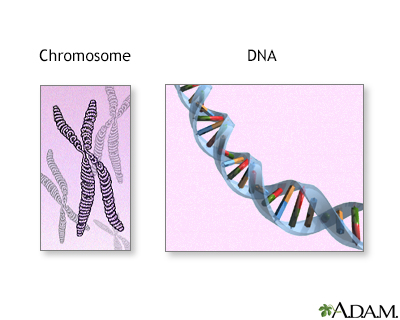Riley-Day syndrome
Riley-Day syndrome; FD; Hereditary sensory and autonomic neuropathy - type III (HSAN III); Autonomic crises - familial dysautonomia
Familial dysautonomia (FD) is an inherited disorder that affects nerves throughout the body.

Humans typically have 23 pairs of chromosomes, or 46 chromosomes in total. Chromosomes are made up of long strands of DNA, which contain all the body's genes.
Causes
FD is passed down through families (inherited). A person must inherit a copy of the variant gene from each parent to develop the condition.
FD occurs most often in people of Eastern European Jewish ancestry (Ashkenazi Jews). It is caused by a change to a gene. It is rare in the general population.
Symptoms
FD affects the nerves in the autonomic (involuntary) nervous system. These nerves manage daily body functions such as blood pressure, heart rate, sweating, bowel and bladder emptying, digestion, and the senses.
Symptoms of FD are present at birth and may grow worse over time. Symptoms vary, and may include:
- Swallowing problems in infants, resulting in aspiration pneumonia or poor growth
- Breath-holding spells, resulting in fainting
- Constipation or diarrhea
- Inability to feel pain and changes in temperature (can lead to injuries)
- Dry eyes and lack of tears when crying
- Poor coordination and unsteady walk
- Seizures
- Unusually smooth, pale tongue surface and lack of taste buds and decrease in sense of taste
After age 3, most children develop autonomic crises. These are episodes of vomiting with very high blood pressure, racing heart, fever, and sweating.
Exams and Tests
Your health care provider will do a physical exam to look for:
- Absent or decreased deep tendon reflexes
- Lack of a response after receiving a histamine injection (usually redness and swelling would occur)
- Lack of tears with crying
- Low muscle tone, most often in babies
- Severe curving of the spine (scoliosis)
- Tiny pupils after receiving certain eye drops
Blood tests are available to check for the variant gene that causes FD.
Treatment
FD can't be cured. Treatment is aimed at managing the symptoms and may include:
- Medicines to help prevent seizures
- Feeding in an upright position and giving textured formula to prevent gastroesophageal reflux (stomach acid and food coming back up, also called GERD)
- Measures to prevent low blood pressure when standing, such as increasing intake of fluid, salt, and caffeine, and wearing elastic stockings
- Medicines to control vomiting
- Medicines to prevent dry eyes
- Physical therapy of the chest
- Measures to protect against injury
- Providing enough nutrition and fluids
- Surgery or spinal fusion to treat spine problems
- Treating aspiration pneumonia
Outlook (Prognosis)
Advances in diagnosis and treatment are increasing the survival rate. About one half of babies born with FD will live to age 30.
When to Contact a Medical Professional
Contact your provider if symptoms change or get worse. A genetic counselor can help teach you about the condition and direct you to support groups in your area.
Prevention
Genetic DNA testing is very accurate for FD. It may be used for diagnosing people with the condition or those who carry the gene. It can also be used for prenatal diagnosis.
People of Eastern European Jewish background and families with a history of FD may wish to seek genetic counseling if they are thinking of having children.
References
Dugoff L, Wapner RJ. Prenatal diagnosis of congenital disorders. In: Lockwood CJ, Copel JA, Dugoff L, et al, eds. Creasy and Resnik's Maternal-Fetal Medicine: Principles and Practice. 9th ed. Philadelphia, PA: Elsevier; 2023:chap 30.
Ryan MM. Autonomic neuropathies. In: Kliegman RM, St. Geme JW, Blum NJ, et al, eds. Nelson Textbook of Pediatrics. 22nd ed. Philadelphia, PA: Elsevier; 2025:chap 655.
Version Info
Last reviewed on: 11/6/2024
Reviewed by: Anna C. Edens Hurst, MD, MS, Associate Professor in Medical Genetics, The University of Alabama at Birmingham, Birmingham, AL. Review provided by VeriMed Healthcare Network. Also reviewed by David C. Dugdale, MD, Medical Director, Brenda Conaway, Editorial Director, and the A.D.A.M. Editorial team.
